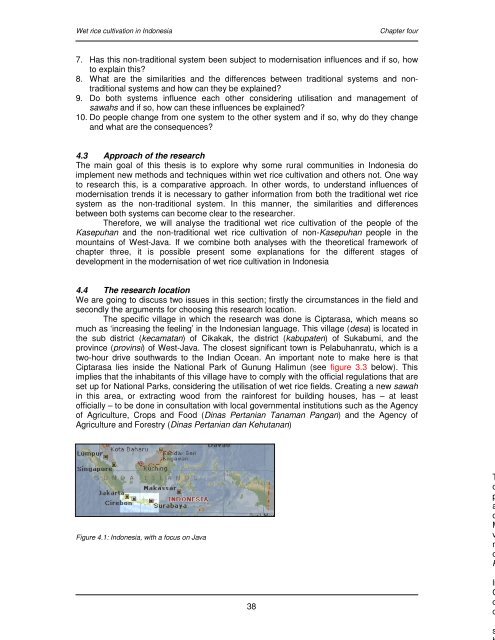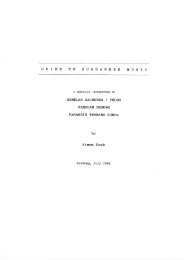Wet rice cultivation in Indonesia - Free EBooks Library
Wet rice cultivation in Indonesia - Free EBooks Library
Wet rice cultivation in Indonesia - Free EBooks Library
You also want an ePaper? Increase the reach of your titles
YUMPU automatically turns print PDFs into web optimized ePapers that Google loves.
<strong>Wet</strong> <strong>rice</strong> <strong>cultivation</strong> <strong>in</strong> <strong>Indonesia</strong> Chapter four<br />
7. Has this non-traditional system been subject to modernisation <strong>in</strong>fluences and if so, how<br />
to expla<strong>in</strong> this?<br />
8. What are the similarities and the differences between traditional systems and nontraditional<br />
systems and how can they be expla<strong>in</strong>ed?<br />
9. Do both systems <strong>in</strong>fluence each other consider<strong>in</strong>g utilisation and management of<br />
sawahs and if so, how can these <strong>in</strong>fluences be expla<strong>in</strong>ed?<br />
10. Do people change from one system to the other system and if so, why do they change<br />
and what are the consequences?<br />
4.3 Approach of the research<br />
The ma<strong>in</strong> goal of this thesis is to explore why some rural communities <strong>in</strong> <strong>Indonesia</strong> do<br />
implement new methods and techniques with<strong>in</strong> wet <strong>rice</strong> <strong>cultivation</strong> and others not. One way<br />
to research this, is a comparative approach. In other words, to understand <strong>in</strong>fluences of<br />
modernisation trends it is necessary to gather <strong>in</strong>formation from both the traditional wet <strong>rice</strong><br />
system as the non-traditional system. In this manner, the similarities and differences<br />
between both systems can become clear to the researcher.<br />
Therefore, we will analyse the traditional wet <strong>rice</strong> <strong>cultivation</strong> of the people of the<br />
Kasepuhan and the non-traditional wet <strong>rice</strong> <strong>cultivation</strong> of non-Kasepuhan people <strong>in</strong> the<br />
mounta<strong>in</strong>s of West-Java. If we comb<strong>in</strong>e both analyses with the theoretical framework of<br />
chapter three, it is possible present some explanations for the different stages of<br />
development <strong>in</strong> the modernisation of wet <strong>rice</strong> <strong>cultivation</strong> <strong>in</strong> <strong>Indonesia</strong><br />
4.4 The research location<br />
We are go<strong>in</strong>g to discuss two issues <strong>in</strong> this section; firstly the circumstances <strong>in</strong> the field and<br />
secondly the arguments for choos<strong>in</strong>g this research location.<br />
The specific village <strong>in</strong> which the research was done is Ciptarasa, which means so<br />
much as ‘<strong>in</strong>creas<strong>in</strong>g the feel<strong>in</strong>g’ <strong>in</strong> the <strong>Indonesia</strong>n language. This village (desa) is located <strong>in</strong><br />
the sub district (kecamatan) of Cikakak, the district (kabupaten) of Sukabumi, and the<br />
prov<strong>in</strong>ce (prov<strong>in</strong>si) of West-Java. The closest significant town is Pelabuhanratu, which is a<br />
two-hour drive southwards to the Indian Ocean. An important note to make here is that<br />
Ciptarasa lies <strong>in</strong>side the National Park of Gunung Halimun (see figure 3.3 below). This<br />
implies that the <strong>in</strong>habitants of this village have to comply with the official regulations that are<br />
set up for National Parks, consider<strong>in</strong>g the utilisation of wet <strong>rice</strong> fields. Creat<strong>in</strong>g a new sawah<br />
<strong>in</strong> this area, or extract<strong>in</strong>g wood from the ra<strong>in</strong>forest for build<strong>in</strong>g houses, has – at least<br />
officially – to be done <strong>in</strong> consultation with local governmental <strong>in</strong>stitutions such as the Agency<br />
of Agriculture, Crops and Food (D<strong>in</strong>as Pertanian Tanaman Pangan) and the Agency of<br />
Agriculture and Forestry (D<strong>in</strong>as Pertanian dan Kehutanan)<br />
Figure 4.1: <strong>Indonesia</strong>, with a focus on Java<br />
38<br />
T<br />
o<br />
p<br />
a<br />
o<br />
M<br />
v<br />
m<br />
o<br />
K<br />
li<br />
C<br />
c<br />
c<br />
s








